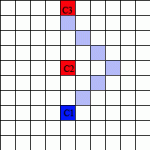Straight move: counts as 2
Diagonal move: counts as 3
To perform a 5f step you are free to do so in any direction.
Remaining move points do not stack from one round to the next. For example if one moves 5 straight squares and 4 diagonal (=22) and has a movement of 23 that extra remaining move point does not carry over to next round unless he is sprinting or unless he is performing a stunt where he claims to cover extra distance than his movement points allow
-see that jumping counts as movement points too: however if one only makes a jump in a round and declares so before initiative is rolled he may not need to make a stunt test. If he loses initiative though and is attacked he will need to make a stunt if he wants to make any jump that along any movement he makes he will be covering a distance beyond his movement points. Furthermore his first attacker gains combat advantage.
Oh, and remember to double the movement of each PC and monster.
Is it ok now?
Diagonal move: counts as 3
To perform a 5f step you are free to do so in any direction.
Remaining move points do not stack from one round to the next. For example if one moves 5 straight squares and 4 diagonal (=22) and has a movement of 23 that extra remaining move point does not carry over to next round unless he is sprinting or unless he is performing a stunt where he claims to cover extra distance than his movement points allow
-see that jumping counts as movement points too: however if one only makes a jump in a round and declares so before initiative is rolled he may not need to make a stunt test. If he loses initiative though and is attacked he will need to make a stunt if he wants to make any jump that along any movement he makes he will be covering a distance beyond his movement points. Furthermore his first attacker gains combat advantage.
Oh, and remember to double the movement of each PC and monster.
Is it ok now?



